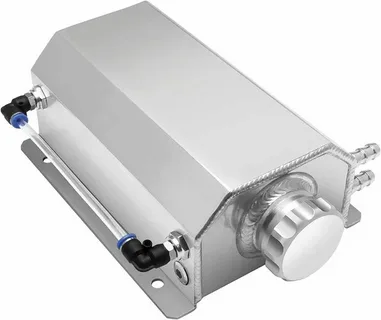Picture this: you’re cruising down the highway, music playing, hair blowing in the wind, when suddenly your dashboard lights up like a Christmas tree. Panic sets in as you realize that your engine is overheating. But what if we told you that preventing such heart-stopping moments could be as simple as understanding one crucial component of your car’s cooling system? Enter the radiator expansion tank! This blog post well dive into its vital role in keeping your engine cool and running smoothly. Whether you’re a seasoned gearhead or just someone trying to keep their ride on the road, mastering the ins and outs of expansion tanks can save you from hefty repair bills—and extend the life of your vehicle! Read on to unlock essential information every car owner should know about these unsung heroes of automotive maintenance.
Introduction To Expansion tanks
Every car owner knows that maintaining a vehicle is more than just routine oil changes and tire rotations. One crucial component often overlooked is the expansion tank. This small but mighty part plays a significant role in your car’s cooling system, acting as the first line of defense against overheating. Imagine cruising down the highway when suddenly, your engine temperature spikes—panic sets in, and you’re left wondering what went wrong.
Understanding how your expansion tank functions can save you from those heart-stopping moments on the road. It not only manages coolant overflow but also ensures proper pressure within the cooling system. Let’s dive into why this unsung hero is essential for every driver and how it helps keep your engine running smoothly under pressure.
Dangers Of Overheating And Why A Expansion tank Is Important
Overheating can spell disaster for your vehicle. When the engine temperature rises beyond normal levels, it puts excessive strain on various components. This stress can lead to blown gaskets, warped heads, and even complete engine failure.
- A expansion tank plays a crucial role in managing this heat.
- It acts as a reservoir for coolant, allowing excess fluid to expand safely when temperatures soar.
- Without it, pressure builds up rapidly in the cooling system, increasing the risk of catastrophic leaks or ruptures.
- The importance of maintaining an effective expansion tank cannot be overstated.
- A well-functioning tank not only keeps your engine cool but also enhances overall performance and efficiency.
- Ignoring its condition could lead to costly repairs down the line—repairs that are easily preventable with proper care and attention.
- Stay vigilant about your car’s heating system; it’s key to ensuring longevity and reliability on every drive.
Understanding The Anatomy Of A Expansion tank
A expansion tank is a crucial component of your vehicle’s cooling system. It’s designed to manage the coolant flow and accommodate changes in liquid volume due to temperature fluctuations. Typically made from durable plastic or metal, this tank features an upper cap that allows steam and excess pressure to escape safely. Inside, you’ll find a baffle that helps maintain fluid levels, preventing air pockets from forming in the system.
The inlet connects directly with the radiator, ensuring proper circulation as temperatures rise. Meanwhile, an outlet leads back into the engine compartment for optimal performance when things heat up. Understanding how each part works together can help prevent overheating issues. Regular inspection of these components is essential for maintaining effective cooling and prolonging your vehicle’s lifespan.
Signs That Your radiator overflow tank May Need To Be Replaced
Spotting issues with your radiator overflow tank early can save you from a major headache. One of the first signs to look for is coolant leakage.
Notice puddles
If you notice puddles forming under your car, it could indicate a cracked or damaged tank. Another red flag is fluctuating coolant levels in the reservoir.
Seem inconsistent
If they seem inconsistent despite no visible leaks, that’s a sign something might be amiss inside the tank.
Pay attention
Pay attention to unusual engine temperatures as well. An overheating engine often hints at cooling system problems, including an ineffective expansion tank. Lastly, check for any warping or bulging on the tank itself.
Physical deformities suggest that pressure build-up may have compromised its integrity and functionality.
Step-By-Step Guide On How To Replace Or Maintain Your Expansion tank
To replace or maintain your expansion tank, start by ensuring your engine is cool. Safety first! Next, locate the expansion tank, typically found near the radiator. Check for any visible cracks or leaks before you proceed. If everything looks fine but still suspect, it’s time to inspect the hoses connected to it.
Drain coolant from the system using a drain pan. Disconnect hoses carefully; they might be stubborn after years of use. Now, remove mounting bolts on the old tank with a ratchet wrench. Take out the old unit and compare it with your new one for compatibility.
Install the new expansion tank by reversing these steps: secure it in place and reconnect hoses tightly. Finally, refill your cooling system with fresh coolant and run your engine briefly to check for leaks around connections. Regular maintenance keeps overheating at bay!
Common Misconceptions About Expansion tanks And Debunking Them
Many car owners believe that a expansion tank is merely an extra component without significant importance. This couldn’t be further from the truth. It plays a critical role in your vehicle’s cooling system. Another misconception is that these tanks do not require maintenance. In reality, regular checks can prevent costly repairs down the line. Neglecting this part may lead to serious overheating issues.
Some people think they can simply ignore cracks or leaks in the tank. However, even minor damage can cause coolant loss, putting your engine at risk. Lastly, many assume all expansion tanks are interchangeable across different makes and models. Each vehicle has specific requirements; using the wrong one could negatively impact performance and safety.
Remember that prevention is always better than cure when it comes to maintaining your vehicle’s performance and longevity. Regularly checking and maintaining all components of your car’s cooling system, including the expansion tank, can save you from potential breakdowns and costly repairs in the future.
Benefits Of Using A Quality Coolant Reservoirs
Investing in a quality Coolant Reservoirs can significantly enhance your car’s performance.
Well-manufactured tank
A well-manufactured tank ensures that coolant levels remain stable, preventing overheating during long drives or under heavy loads.
Durability
Durability is another key benefit. High-quality materials resist corrosion and wear, extending the lifespan of the entire cooling system. This means fewer repairs and longer intervals between maintenance checks.
Reliable expansion tank
A reliable expansion tank also contributes to efficient temperature regulation. It helps dissipate heat effectively, allowing your engine to run smoothly without unnecessary strain.
Top-tier product
Furthermore, using a top-tier product can improve overall fuel efficiency. When the cooling system works optimally, it allows the engine to operate at its best, saving you money at the pump.
In short, choosing a premium expansion tank safeguards against costly damage while promoting longevity in your vehicle’s performance.
Alternative Solutions For Preventing Overheating: Coolant Expansion Tank
When traditional cooling systems aren’t an option, creativity becomes essential. Electric fans can be a game-changer. They provide targeted airflow, helping to keep engine temperatures down effectively.
Another alternative is using heat exchangers. Coolant Expansion Tank devices transfer excess heat away from the engine, ensuring optimal operating temperatures without relying on conventional coolant methods. For those looking for quick fixes, radiator waterless coolant could be considered. This specialized liquid has a higher boiling point and helps manage temperature under pressure better than standard coolants.
Additionally, improving air circulation around your vehicle can help significantly. Ensuring vents are unblocked and that there’s adequate space between the car and surrounding objects allows for better airflow. Lastly, regular maintenance checks play a vital role in preventing overheating issues. Keeping components clean and clear reduces the risk of temperature spikes in any system setup you opt for.
Proper Care And Maintenance Of Radiator Overflow Bottles
Taking care of your car’s cooling system is essential for ensuring a smooth and reliable driving experience. The Radiator Overflow Bottles plays a pivotal role in this system, helping to regulate coolant levels and preventing overheating. By understanding its function, recognizing the signs that it may need attention, and following proper maintenance practices, you can protect your vehicle from costly repairs down the line.
Remember that investing in a quality expansion tank not only enhances performance but also contributes to the longevity of your engine. It’s worth debunking common myths surrounding these components as well – knowledge is power when it comes to car maintenance.
If you find yourself facing issues with overheating or suspect problems with your expansion tank, don’t hesitate to seek professional assistance or consider replacements if necessary. Your car deserves the best care possible for optimal performance on every journey.
Conclusion
Coolant Reservoirs play a crucial role in preventing overheating and maintaining the optimal operating temperature for your car. They serve as a reservoir for excess coolant and help regulate pressure within the cooling system, which is vital for preventing damage to your engine. Make sure to regularly check your expansion tank for any leaks or cracks, and top off the coolant if necessary. If you notice any issues with your cooling system, such as frequent overheating or loss of coolant, it is important to have it inspected by a professional mechanic.
FAQs
Q: Can I drive my car without an expansion tank?
A: It is not recommended to drive without an expansion tank as it could result in excess pressure building up within the cooling system leading to potential damage to the engine. It is best to have a professional replace a faulty expansion tank rather than removing it completely.
Q: What happens if there is too much coolant in my Coolant Reservoirs?
A: Having too much coolant in your Coolant Reservoirs can cause problems such as foaming or air pockets in the cooling system. It is important to follow manufacturer guidelines when filling up your vehicle’s coolant level and always use distilled water instead of tap water.
Q: How often should I replace my expansion tank?
A: The lifespan of an average plastic or metal expansion tank is around 100,000 miles. However, this can vary depending on driving habits and maintenance routines. It’s best practice to have an experienced mechanic inspect the integrity of your car’s cooling system during regular servicing intervals.
| Related Business Listings |
| Contact Directory |
| Local Business Profiles |




